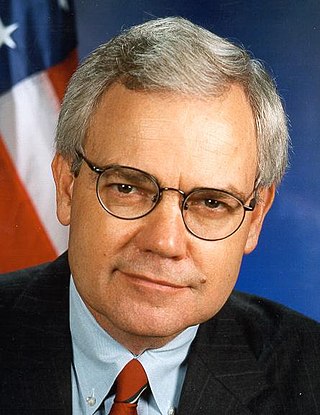
James Ralph Sasser was an American politician, diplomat, and attorney. A Democrat, Sasser served three terms as a United States senator from Tennessee from 1977 to 1995, and was Chairman of the Senate Budget Committee. From 1996 to 1999, during the Clinton Administration, he was the United States Ambassador to China.

Robert Nelson Clement is an American politician and academic administrator. He is a member of the Democratic Party and served in the United States House of Representatives, representing Tennessee, from 1988 until 2003, when he retired to run unsuccessfully for the United States Senate.

The 1994 United States Senate elections were held November 8, 1994, with the 33 seats of Class 1 contested in regular elections. Special elections were also held to fill vacancies. The Republican Party took control of the Senate from the Democrats. Like for most other midterm elections, the opposition, this time being the Republicans, held the traditional advantage. The congressional Republicans campaigned against the early presidency of Bill Clinton, including his unsuccessful healthcare plan. Democrats held a 56–44 majority, after having lost a seat in Texas in a 1993 special election.

The 1988 United States Senate elections were elections for the United States Senate. Held on November 8, 1988, the 33 seats of Class 1 were contested in regular elections. In spite of the Republican victory by George H. W. Bush in the presidential election, the Democrats gained a net of 1 seat in the Senate. 7 seats changed parties, with 4 incumbents being defeated. The Democratic majority in the Senate increased by one to 55–45.

The 1984 United States Senate elections were held on November 6, with the 33 seats of Class 2 contested in regular elections. They coincided with the landslide re-election of President Ronald Reagan in the presidential election. In spite of the lopsided presidential race, Reagan's Republican Party suffered a net loss of two Senate seats to the Democrats, although it retained control of the Senate with a reduced 53–47 majority.

The 1982 United States Senate elections were held on November 2, 1982. They were elections for the United States Senate following Republican gains in 1980. The 33 Senate seats of Class 1 were up for election in 1982. A total of four seats changed hands between parties, with Democrats winning seats in New Jersey and New Mexico, and Republicans taking seats in Nevada and the seat of the lone independent, Senator Harry Byrd Jr., in Virginia. Democrats made a net gain of one seat bringing them to 46 seats, while Republicans stayed at 54 seats for a majority. However, the Democratic gain in New Jersey replaced a Republican that had been appointed earlier in the year. Liberal Republicans senators in Connecticut, Rhode Island and Vermont held onto their seats, keeping the Senate in Republican hands.

The 1978 United States Senate elections were held on November 7, in the middle of Democratic President Jimmy Carter's term. The 33 seats of Class 2 were contested in regular elections. Special elections were also held to fill vacancies.

The 1930 United States Senate elections occurred in the middle of Republican President Herbert Hoover's term. The 32 seats of Class 2 were contested in regular elections, and special elections were held to fill vacancies. With the Great Depression beginning to take hold, Republican incumbents became unpopular, and Democrats picked up a net of eight seats, erasing the Republican gains from the previous election cycle, however, Republicans retained control of the chamber. This was the first of four consecutive Senate elections during the Depression in which Democrats made enormous gains, achieving a cumulative pick-up of 34 seats.

The 1994 United States Senate election in Tennessee was held November 8, 1994. Incumbent Democratic U.S. Senator Jim Sasser ran for re-election to a fourth term but was defeated by Republican nominee Bill Frist. This is the last time that a Senator from Tennessee lost re-election.

The 1994 United States Senate special election in Tennessee was held November 8, 1994. Incumbent Democratic Senator Al Gore resigned from the Senate following his election as Vice President of the United States in 1992, and this led to the 1993 appointment of Harlan Mathews and the subsequent special election. Mathews did not seek election to finish the unexpired term, and Representative Jim Cooper subsequently became the Democratic nominee. However, the Republican nominee Fred Thompson won the seat in a decisive victory.

The 1984 United States Senate election in Texas was held on November 6, 1984. Incumbent Republican U.S. Senator John Tower decided to retire, instead of seeking a fifth term. Republican Phil Gramm won the open seat.

The 1988 United States election in Tennessee was held on November 8, 1988. Incumbent Democratic U.S. Senator Jim Sasser won re-election to a third term, defeating Republican nominee Bill Andersen with 65.1% of the vote.

The 1964 United States Senate special election in Tennessee was held on November 3, 1964, concurrently with the U.S. presidential election as well the other regularly scheduled U.S. Senate election, as well as other elections to the United States Senate in other states as well as elections to the United States House of Representatives and various state and local elections. Following the death of Senator Estes Kefauver, Governor Frank G. Clement appointed Herbert S. Walters to fill the vacancy until the special election could take place. Walters decided not to run in the special election. Democratic nominee Ross Bass won the election, defeating Republican Howard Baker with 52.1% of the vote.

The 1988 United States presidential election in Tennessee took place on November 8, 1988. All 50 states and the District of Columbia were part of the 1988 United States presidential election. Tennessee voters chose 11 electors to the Electoral College, which selected the president and vice president. Tennessee was won by incumbent United States Vice President George H. W. Bush of Texas, who was running against Massachusetts Governor Michael Dukakis. Bush ran with Indiana Senator Dan Quayle as Vice President, and Dukakis ran with Texas Senator Lloyd Bentsen.

The 1952 United States Senate election in Tennessee was held on November 4, 1952. Incumbent Democratic Senator and President pro tempore of the Senate Kenneth D. McKellar ran for re-election to a seventh term in office but was defeated in the Democratic primary by U.S. Representative Al Gore Sr. Gore easily won the general election against Republican Hobart Atkins.

The 2020 United States Senate election in Tennessee was held on November 3, 2020, concurrently with other elections to the United States Senate. The 2020 U.S. presidential election and elections to the U.S. House of Representatives were also held, as well as the State Senate and State House elections. Incumbent Republican Senator Lamar Alexander announced that he would not run for re-election on December 17, 2018. The former United States Ambassador to Japan, Bill Hagerty won the open seat by a large margin defeating his Democratic opponent Marquita Bradshaw.

The 1946 United States Senate election in Tennessee was held on November 5, 1946. Incumbent Democratic Senator Kenneth D. McKellar was re-elected to a sixth term in office. He defeated a primary challenge by Edward W. Carmack Jr. and easily won the general election against Republican William B. Ladd, and Independent candidate John Randolph Neal Jr.

The 1960 United States Senate election in Tennessee took place on November 8, 1960, concurrently with the U.S. presidential election, as well as elections to the United States Senate in other states as well as elections to the United States House of Representatives and various state and local elections. Incumbent Democratic Senator Estes Kefauver won re-election, defeating Republican candidate A. Bradley Frazier.

The 1964 United States Senate election in Tennessee was held on November 3, 1964, concurrently with the U.S. presidential election as well the other U.S. Senate special election in Tennessee, as well as other elections to the United States Senate in other states as well as elections to the United States House of Representatives and various state and local elections.

The 1966 United States Senate election in Tennessee was held on November 8, 1966, concurrently with other elections to the United States Senate in other states as well as elections to the United States House of Representatives and various state and local elections. Republican nominee Howard Baker won the election, defeating Democratic nominee and Tennessee Governor Frank G. Clement with 55.7% of the vote.















